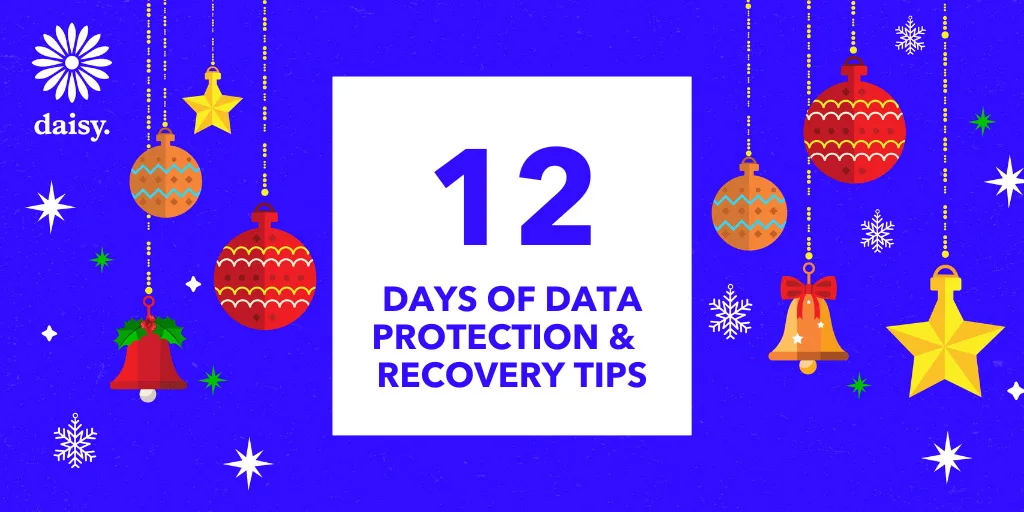

‘Tis the season for giving, and as we embrace the festive spirit, our operational resilience experts bring you the gift of knowledge with our 12 days of data protection and recovery tips.
Utilise these top tips for peace of mind, so the only thing giving you sleepless nights this Christmas will be the sound of Santa’s sleigh!
1. Be prepared (it’s not if, it’s when)
If this is the only tip you take away, make sure it’s this! Being prepared can take many forms but if you act on these two things, you won’t regret it…
Having a regular and automated backup process in place is the key to ensuring your business gets back up and running effectively when disaster strikes.
Secure, clean, isolated recovery environments have become more relevant with the proliferation of cyber threats. This involves three steps: Identify your key assets, put a physical recovery plan in place to recover them and then ensure that you have tested that the plans work – your business depends on this.
2. Prioritise backup for when disaster strikes
Effective data protection starts with prioritising backup. Safeguard on-premises, hybrid, and public cloud systems, applications, and data. Key considerations include choosing a backup and replication provider with proven recovery experience, and features such as air-gapped storage to combat cyber threats, and an integrated archive tier for cost-effective long-term retention.
3. Follow the 3-2-1 backup rule
Adopt the 3-2-1 backup rule for resilience against data loss:
- 3 copies: Keep original data and two additional copies
- 2 different media: Store copies on different devices to reduce the risk of failure
- 1 off-site location: Keep one copy off-site to protect against local disasters
This is a proven way to enhance reliability and resilience in the face of unexpected data loss scenarios.
4. Stop keeping your data protection and cyber security operations in silos
Business continuity and disaster recovery (BCDR) plans need to become more closely affiliated with cyber security plans. The cyber threat landscape is demanding those disciplines merge into modern cyber protection – it’s important to recognise that backup without integrated cyber security is insufficient, as is cyber security without integrated backup.
5. Get the right people involved!
Data protection, disaster recovery, and business continuity are business decisions, not just technical ones. Ensure that the protection and recovery process is understood and actively implemented at all levels and functions within your organisation, to avoid any critical elements being omitted from the plans.
6. Practice recovery scenarios
You might already have a robust backup routine in place, but when was the last time you verified its functionality?
Verify the functionality of your backup routine by conducting regular tests. From basic file tests to more comprehensive scenarios, ensure your backup processes are reliable without jeopardising the integrity of live systems.
7. Implement a data retention policy
Maintain control over your data, ensure compliance and mitigate legal risks by implementing a data retention policy. This not only improves efficiency but also helps avoid unnecessary storage costs and potential security breaches associated with retaining data for longer than necessary.
8. Stay up to date
With new threats emerging daily, staying up to date with emerging trends and vulnerabilities is imperative. Always make sure that you have the latest security patches/ software version installed, and configured correctly, in order to reduce risks associated with outdated systems.
9. Ensure that your service provider can meet SLAs
Your service provider should be contractually committed to SLAs that align with your Recovery Time Objectives (RTO) and Recovery Point Objectives (RPO) on a 24/7/365 basis.
10. Run a pre-contract Proof of Concept (POC) when selecting a data protection and recovery provider
Before committing to a data protection and recovery service provider, make sure that you conduct a pre-contract POC to ensure that the service meets your businesses specific needs and expectations.
11. SaaS applications don’t back up your data!
SaaS applications such as M365, OKTA, Salesforce, Atlassian and many more, hold your data. They operate on a shared responsibility model, the provider keeps the lights on, feeds and waters it, BUT YOU ARE RESPONSIBLE FOR THE BACKUPS.
Microsoft’s own service agreement states that the customer should regularly back up their M365 content and data using third-party apps and services. Whether it is for compliance with your retention policies or addressing the risk posed by a cyber breach, or accidental deletion, consider selecting an affordable, simple-to-deploy M365 backup product
12. Encryption and immutability are key
The value of your data to an outsider is immeasurable. Ensuring the immutability of your backup data is a fundamental step in protecting your information. Intruders may attempt exfiltration, but encrypting both your data at rest and the backups themselves guarantees that even if data is taken, it remains inaccessible and useless to unauthorised parties. Without these precautions, there’s a risk of your data being exposed and made public.
One final tip…
Think of your data and applications like your life savings – what more can you do to protect them?
That’s a wrap on our 12 days of data protection and recovery tips! Need some help with your data protection and recovery strategy? We are here to help!